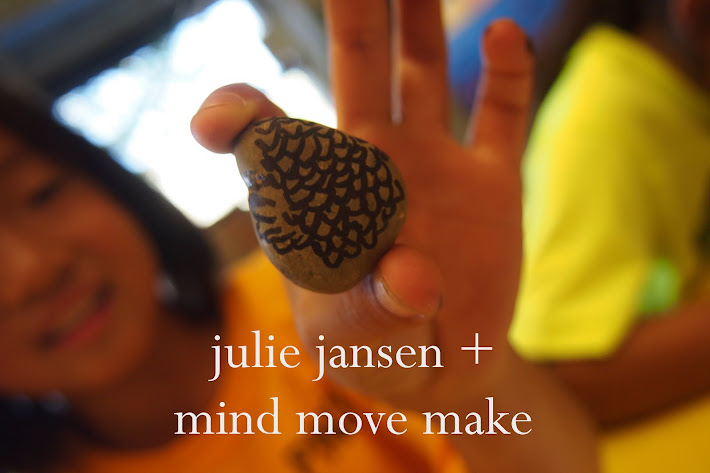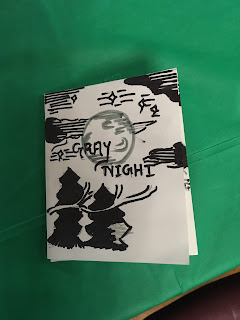 |
| We will use this book to learn more about John James Audubon |
During our first class together we spent some time getting to know one another to begin to build a sense of community. I explained that during each class we will start by sitting together in a circle and exploring a different breathing practice. The first one I taught them was Shark Fin Breath. While we took the time to settle into the new space of the classroom and breathe together, I asked them to check in with how they were feeling. Life is moving so quickly that sometimes we forget to check in with ourselves and investigate how we are in the moment. In Mind Move Make class I like to give space for each child to do this.
After taking a few deep, refreshing breaths together I introduced the idea of lightning rounds. Lightning rounds provide a way to bring each child's voice into the room and share in any way they choose. We started by simply sharing our names and going around the circle. For our second Lightning Round we said our names and created a motion to go with our names. Everyone in the group repeated every other child's name and action. I call this Pass the Movement, and it is a game we return to often.
Then we had a discussion of what Mind Move Make class is all about! MIND stands for MINDFULNESS! I asked if anyone wanted to share their ideas of what mindfulness is. "Mindfulness is being calm," one child shared. Many of the children agreed that this was true. I shared that mindfulness is paying attention to what is happening RIGHT NOW. It is paying attention to what is happening INSIDE of us (thoughts, feelings, body sensations) and OUTSIDE of us (sounds, sights, other people/animals/plants, the wind, weather, water, and on and on). MOVE stands for MOVEMENT! In our class, movement will be yoga along with lots of other types of movement. And MAKE stands for making artwork.
We also took the time to go over some expectations I have, and here they are:
- Respect everyone
- Show kindness to everyone
- Respect the classroom
- Respect the materials we use
I asked if everyone could do these four things during our time together and we put all of our hands together in the middle of the circle in a cheer as a way of sealing our agreement to be kind and respectful.
Then I introduced the Quick Draw Challenge, which is another form of Lightning Round we will use together. Everyone received a whiteboard and a black pen. I asked them to draw a picture of how they were feeling in that moment. They had two minutes to complete their drawings, then we went around and shared both the drawings and feelings. There was a range of different feelings: tired, happy, angry, nervous, calm, sad. It was interesting to get a glimpse into each child's internal landscape through this practice.
After that we transitioned to using the yoga mats and bringing more movement into our class! We started by taking three volcano breaths together. I invited the children to become a loud, exploding volcano with our first breath, then to practice the second two breaths in a more calm way. Then we brought attention to our feet and made circles around our center point. When everyone found their center, we discovered our STRONGEST mountain pose! I went around and tried to knock these beautiful mountains over, but they were too strong for me! Then we played Shake Shake Mountain! The children could move, wiggle, and shake in any way they wanted on their yoga mats while I created a rhythmic sound with an instrument. When I stopped playing the instrument, the students were invited to freeze, slowly come back to mountain pose, and take three deep breaths.
Then I invited the students to bring their arms apart in a wide gesture, as if they were ready to give someone a huge bear hug! All together we brought our hands together in a loud "CLAP", then we rubbed our hands together for about 30 seconds. I asked them to hold their hands apart just a few inches and describe the sensation in their hands. "My hands feel fizzy! Like a glass of fizzy water," one girl stated. Many other students agreed that their hands also felt fizzy. Tingly was another way a student described the sensation in her hands after trying this exercise.
After moving through a few more yoga poses, we began our art practice. In order to get to know one another better, the children were to choose their favorite thing they like to do and make a drawing of themselves doing that thing! It was fun to see the different activities the students love doing.
Then I invited the students to bring their arms apart in a wide gesture, as if they were ready to give someone a huge bear hug! All together we brought our hands together in a loud "CLAP", then we rubbed our hands together for about 30 seconds. I asked them to hold their hands apart just a few inches and describe the sensation in their hands. "My hands feel fizzy! Like a glass of fizzy water," one girl stated. Many other students agreed that their hands also felt fizzy. Tingly was another way a student described the sensation in her hands after trying this exercise.
After moving through a few more yoga poses, we began our art practice. In order to get to know one another better, the children were to choose their favorite thing they like to do and make a drawing of themselves doing that thing! It was fun to see the different activities the students love doing.





















